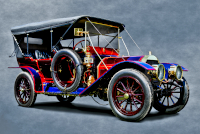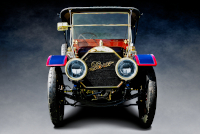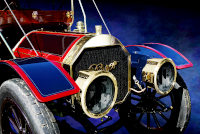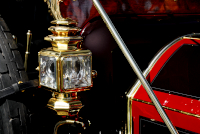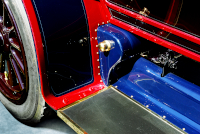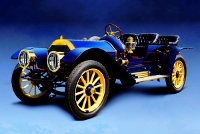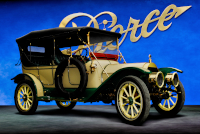Location:
Radnor Hunt Concours d'Elegance, 2009
Owner: Whitman & Lynne Ball | Exton, Pennsylvania
Prologue:
The Ball family owned chassis #7940 for over 60 years, from William's purchase in 1952 to its eventual sale at auction in 2013. We photographed the car in 2009, the same year in which it emerged from a lengthy restoration. William had disassembled the Pierce in 1975, and so it lay an unfinished project until his son Whit re-started the process around 2002. The car has since been sold, but for a few years following its concours debut appeared frequently at east coast events.
I originally published the main image on an old website, a less-disciplined forerunner to 12cylinders. That photo seems to have kicked around the internet for a while, such is the fondness for the car's multicolor livery. Now refinishing the main image for the Pierce-Arrow portfolio build, I've added the remaining photos snapped back in 2009. Not my best work, but colorful enough for the sake of the larger project.
- - - - - - - - - -
► Image Source: Nikon D200 (10.2 MP)
References:
- Ralston, Marc. "Pierce-Arrow, The Golden Age" Jostens Publications, Clarksville, TE. 1984, page 33
- RM Sotheby's: The 2013 auction listing for chassis #7940.
A piece of Delaware Valley history, this Pierce-Arrow's second owner was Francis Victor du Pont of the du Pont Chemical family. Known as Frank, he acquired the Model 48-SS from its original owner, where it became part of his antique car collection. In the greater Philadelphia region, the du Pont legacy often recalls mansions and gardens and vast collections of antiques, as many of the family estates currently operate as museums. The most prominent of these estates are Hagley Museum, Longwood Gardens, and Winterthur.
Not unlike his ancestors, Frank possessed a scientific mind. He graduated from MIT and long served on the Delaware State Highway Commission, ultimately becoming Administrator of the Federal Highway Administration under Dwight D. Eisenhower. In that time, he supported the development of the Delaware Memorial Bridge. Not simply for the sake of quoting encyclopaedic facts, I'm fond of this connection because my grandfather was at the time an engineer for US Steel, which supplied material for the Delaware Memorial Bridge.
Though I never met my grandfather, he worked on many major highway projects along the east coast, so traveling across a bridge or through tunnels became ceremony in our car. The Delaware Memorial Bridge was indeed one of his projects, a suspension bridge he inspected by walking the cables and towers. Such was the state of American work in the middle of the 20th century, whether driven by a man of the du Pont legacy, or my grandfather. I can fathom that at least one was aware of the other, both being engineers close to the same project. Coincidentally both men were also pilots. These are all intangible connections of course, but from a long-distant glance into the past, those connections are what a bridge or a car comes to represent.
Much can also be said of the fourth owner's stewardship, the Ball family, who owned the car for over 60 years beginning with William in 1952 and ending with Whitman and Lynne in 2013. The family often toured the car, including numerous Glidden Tours (in true Pierce-Arrow fashion). A mud-soaked 1957 edition ended in the AAA award for the most typical Glidden Tour car, an award AAA then retired with William and the Pierce-Arrow. Later in this period, #7940 underwent a lengthy retirement and restoration process—disassembled in 1975, and not fully restored after the turn of the century.
Motor: 8,603 cc (525 cubic inch) straight 6-cylinder in three cast iron blocks | 114.3 mm x 120.65 mm (4½" x 4¾")
Valvetrain: T-head, single plug
Power: 48 rated hp @ 1,600 rpm
Drivetrain: floor-shift, four-speed selective sliding-gear manual transmission, rear-wheel drive
Front Suspension: semi-elliptical leaf springs
Rear Suspension: live axle with semi-elliptical leaf springs
Architecture: cast alloy body on pressed manganese steel rear-drop frame
Kerb Weight: 1,868.8 kg (4,120 lbs)
Wheelbase: 3,416.3 mm (134.5 inches)
Etymology:
In 1910, Pierce-Arrow simplified its offerings among the 36-UU, 48-SS, and 66-QQ; all are 6-cylinder models. Each number designation corresponds to rated horsepower. The letters follow a somewhat cryptic sequence. The Model 48-SS succeeded the 6-cylinder 40-S of late 1908, though the lineage would be difficult for most to spot. Pierce-Arrow built only 350 of the short-lived 40-S in 1908, whereas the 48-SS proved prolific, with approximately 3,000 produced over four years. Anyone without a handy catalogue of Pierce-Arrow models would be hard pressed to piece together the ancestry.
Figures:
Pierce-Arrow produced 817 Model 48-SS cars in 1910. Note that chassis #7940 escapes mention in Marc Ralston's work from the 1980s because the car had been disassembled as of 1975.
Value:
In 2013, Chassis #7940 sold at RM Sotheby's Hershey auction for $687,500.
Not Protected: Open-Plan Motoring in the Early Pierce-Arrow
While the 1910 Model 48-SS looks a complete touring car, Pierce-Arrow are yet to add front doors. The drivers side remains blocked by the spare, (quite common), whereas the passenger side is open. Touring models will gain front doors in 1911 on a special protected Touring model.
Horn Play: Horn Location Compared to 1910 Pierce-Arrow Specification
Note the position at which the hose connected to the horn enters the bulkhead. In a 1910 model, the horn bulb should sit on the floor of the cabin, which the driver can then stomp, as opposed to winding the hose up to a hand-operated bulb. The horn returned to a higher, hand-operated position in 1911. Chassis #7940 seems to use a hand-operated configuration, however, with the bulb attached to the steering column. The switch may be a practical concession to contemporary road use, as the stomp horn seemed unpopular. Even Pierce-Arrow later edited hand-operated horns into its 1910 factory photographs.
Closed Boards: Updated Running Equipment on the 1910 Pierce-Arrow
A more practical improvement, 1910 models are distinguishable from 1909 models by running gear enclosed with splash pans along the boards. We depict some of the splash pan configuration in photo 5.
Wild Livery: Applauding the Multicolor Livery of Pierce-Arrow #7940
Of course the most prominent feature of chassis #7940 is its paint. A sophisticated burgundy offsets bright red and blue primary colors, mixed with brass and wood to create an interchanging dance of body panels and moulding lines. When a brass era car takes advantage of contrast to this extent, people notice. So has this car become a pleasing favorite among Pierce-Arrow fans. And if we are ever reacquainted, I will do better to show as much than 2009 allowed.
Last Updated: Mar 26, 2025

